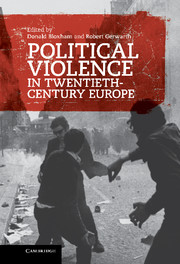1 - Europe in the world: systems and cultures of violence
Published online by Cambridge University Press: 05 June 2012
Summary
During recent years a series of important studies have attempted to deal synthetically with violent aspects of European history in the twentieth century. All of them refer to and replicate aspects of Eric Hobsbawm's masterpiece Age of Extremes: the Short Twentieth Century 1914–1991 (1994), which in turn demarked that century from the ‘long nineteenth century’ with which Hobsbawm concluded his Age of Empire 1875–1914 (1987). Key analyses in the ‘classic’ works of Volker Berghahn, Ian Kershaw and Mark Mazower share three broad arguments: first, they demonstrate the important role played by ideologies. Liberalism, different variants of aggrandizing nationalism, including colonial imperialism and Nazism, as well as socialism and Soviet communism were, in different phases, instrumental in intensifying political violence (or, as Kershaw terms it, ‘state-sponsored violence’) during the twentieth century. Mark Mazower reminds us in this respect of two realities: during the twentieth century, Europe was not on the whole shaped by a convergence of thinking and feeling, but by a series of violent clashes of diametrically opposed New Orders; and National Socialism, fascism and communism were not alien or novel imports into Europe but grew out of the heritages of previous periods of European history. What was new therefore in the twentieth century was not that there were such ideologically driven conflicts, but their intensity. This owed something to the novel harshness of the expression of these ideologies, but was also a consequence of new means of expression.
- Type
- Chapter
- Information
- Political Violence in Twentieth-Century Europe , pp. 11 - 39Publisher: Cambridge University PressPrint publication year: 2011
- 2
- Cited by



